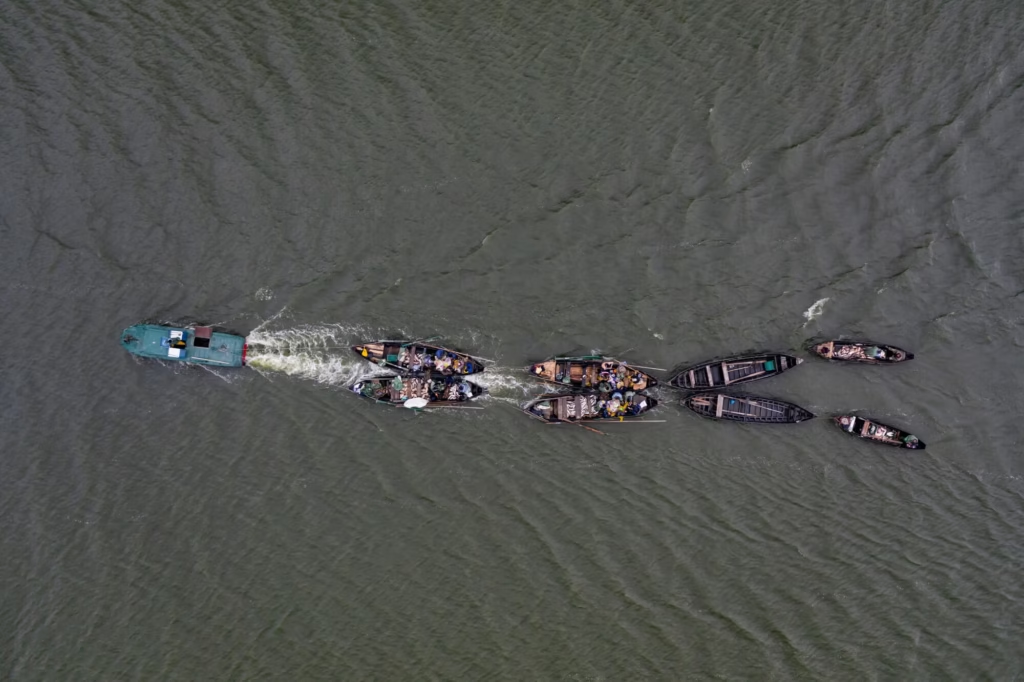In 2024, extreme weather in the Indo-Pacific led to an exceptional number of natural disasters across its area. Natural disasters, such as cyclones, floods, and wildfires, have killed millions of people. The disasters created extensive damage to entire populations. The disturbing pattern of disasters has established itself in recent times. Climate resilience approaches undergo rapid transformation because of this emerging trend. A population of 4.5 billion people in the Indo-Pacific region is exposed to climate change. Due to this strategic location, extreme weather events challenge this region like never before. The Philippines frequently experiences typhoons. Bangladesh faces increasingly severe floods. The need to act as proactive protectors before disasters happen has never been more important.

Scientists thoroughly prove how climate change produces extreme weather conditions. These extreme weather phenomena become increasingly dangerous. Rising ocean temperatures combine with enlarged sea level rise and shifting atmospheric conditions to trigger these events on a regular basis. Several communities now experience intensifying risks from extreme storms, floods, and heatwaves. These conditions exceed the response capabilities of the affected communities. Direct intervention at individual and community levels, together with governmental action, leads to minimal fatalities caused by weather conditions. The steps suggested in this article lead to economic damage reduction as well. Detailed protective processes to defend both human life and built infrastructure will be discussed. Strategies exist that can shield economies from unending natural disasters. These types of natural occurrences are rising in frequency throughout this part of the world.
Understanding Extreme Weather in the Indo-Pacific
The Indo-Pacific region presents a complex area spanning across Africa toward the Pacific Islands. Extreme weather patterns frequent this location because of natural terrain factors alongside human-induced environmental modifications. The critical first step in understanding preparedness it is essential to analyze extreme weather patterns in this region and their increased severity together with their global consequences.
Types of Extreme Weather Events in the Indo-Pacific
1. Cyclones and Typhoons:
Extremely harsh weather in the Indo-Pacific creates massive destruction through torrential storms. Typhoons serve as one of the region’s most common destructive weather phenomena. Three nations in the Indo-Pacific region face yearly threats from these storms that occur during typhoon season. The Philippines, Japan, and Vietnam make up the three nations affected by extreme weather in the Indo-Pacific region. The disturbance systems in these regions combine strong winds with heavy rainfall. The 2020 destruction from Typhoon Goni exceeded $1 billion in total damage. History recorded Goni when it pounded the Philippines with extraordinary strength as one of its worst tropical storms. Numerous villages disappeared as floodwater covered them completely, with several thousand homes being completely destroyed by the natural disaster.
2. Floods and Storm Surges:
Storm surges increase existing flooding challenges, which the region faces a lot. Areas like Bangladesh and some parts of India experience seasonal storms during monsoon season when cyclones produce damaging flood conditions. Research reports show that Bangladesh experienced its worst flooding in 2022, when monsoon flooding combined with rising sea levels pushed 7 million citizens to abandon their homes. During severe floods, infrastructure collapses as crops completely disappear, along with people losing their livelihoods.
3. Heatwaves and Droughts:
The worldwide increase in temperatures has produced more intense heatwaves in countries like Thailand and Australia. The combination of extended heatwaves creates both health dangers for people and causes supply shortages and damaging outcomes for agriculture.
Causes and Trends
Extreme weather phenomena in the Indo-Pacific region evolve from natural weather processes working alongside human-made factors. Rising global temperatures function as the fundamental driver behind changes occurring in ocean and atmospheric environments. Cyclonic storms gain intense power from warmer ocean waters, yet deforestation and fast urban development eliminate protective coastal elements such as mangroves and wetlands.
The Indo-Pacific region’s events evolve under the influence of geographic features. Countries located near seismic faults and storm-exposed coastal zones face increased risks from earthquakes, tsunamis, and storms throughout this region. Human activities have transformed natural perils into substantially more threatening threats. Global warming is getting worse because of high fossil fuel consumption, while poor urbanization planning reduces drainage efficiency.
How to Prepare for Extreme Weather Events
Every strategy related to extreme weather protection requires specific solutions that cannot be standardized. Learning the detailed dimensions of weather risks that specifically affect your region is essential so businesses, community leaders, and government officials can initiate effective protective measures. The following detailed practical approaches can help humans and communities limit extreme weather event impacts.
Getting Ready for Emergencies
1. Create an Emergency Kit:
The main way people protect themselves from extreme weather requires preparing necessary supplies beforehand. Families must stock up their emergency kits with water. They should include non-perishable foods and required medication. First aid kits, flashlights, battery packs, and essential documents are necessary. A radio that operates on battery power is also important. Families in the Philippines experienced fewer casualties during typhoon events because they established evacuation kits prior to emergencies. This basic preparation measure guarantees complete safety for your family in unpredictable emergencies.
2. Learn Your Escape Routes and Safe Places:
You need to learn your evacuation routes ahead of time before areas affected by cyclones, floods, and heatwaves. The Mozambican communities that implemented evacuation routes alongside shelters during Cyclone Idai suffered fewer fatalities after the storm. Storms block and destroy roads quickly, which is why knowing alternate paths to shelters and your prepared evacuation plan helps save people.
3. Make Your Home Safer for Disasters:
You should take steps to protect your house from catastrophic weather conditions. Easy home protection solutions combining storm shutters with roof strengthening and flood-resistant house elevation measures prevent damaging expenses. The people in Indonesian areas that experience flooding built elevated residential buildings on stilts to protect against increasing waters. Repeated home improvement efforts that seem small will create substantial protection once weather disasters arise.
4. Stay Updated with Trusted Information:
Make sure you receive the latest warning updates from trusted national meteorological services and local administrative units as well as mobile applications. Real-time information plays a fundamental protective role in saving lives. The Japan Meteorological Agency delivered quick storm alerts in 2020, which enabled millions to evacuate safely before Typhoon Haishen hit.
How the Government Helps with Extreme Weather Preparedness
Public authorities remain essential to both organizational frameworks and financial investments for preparing countries against severe weather hazards. National and regional policy choices create substantial reductions in extreme weather effects against vulnerable population groups.
A. Creating Strong Plans for Climate Issues
Allied powers must create and enforce climate-resilient policies that incorporate risk reduction practices with preparedness approaches throughout every sector. The Australian government invested in flood mitigation programs, using programs that mapped floodplains combined with zoning rules and programs that educated the public about flood risks. Mitigation of human costs together with financial losses associated with floods has improved significantly due to these efforts.
B. Spending Money on Disaster Response Resources
Government institutions need to establish disaster response infrastructure development as their top priority. Emergency preparedness activities include operations of properly equipped evacuation areas, maintenance of operational communication systems, and fast response from emergency teams to reach affected regions. When the 2004 Indian Ocean tsunami destroyed communities in Indonesia and Thailand, their governments restored the areas by building resilient systems with improved access. Subsequent disasters revealed benefits from the prior disaster preparedness, allowing these countries to handle emerging crises effectively.
C. Working Together with Other Countries for Help
Extreme weather phenomena surpass country limits to require collaboration among international parties. The progress of unified weather forecasting programs is actively being pursued by member states across Asia-Pacific territories. These entities work jointly to control risks from disasters while conducting relief operations. The Pacific Islands Forum creates essential operations for member nations. Through these programs, governments can exchange valuable assets with their participating partners. Partner organizations use mutual learning to respond against collective foreign security challenges. Flowing support arrived from New Zealand firefighters when Australia experienced bushfires in 2020. The display of regional unity became possible because of this decision. The scenario showed how effective it is when local communities support each other.
Investment in science combined with active policy initiatives and infrastructure enhancements decreases the magnitude of extreme weather event consequences. The investments will create safer conditions that guard both the people and their prosperity.
Examples of Good Preparation for Extreme Weather in the Indo-Pacific
Real-world examples across extreme weather in the Indo-Pacific region demonstrate which strategies, alongside measures, have proven successful for death prevention while decreasing infrastructure losses from intense weather events. The research projects from these regions teach vital lessons that help other locations address their emergency response needs.

A. Typhoon Haiyan – The Philippines
In November 2013, Haiyan (Yolanda) grew into history’s most forceful tropical cyclone as it blasted sections of the Philippines, causing heavy devastation. Disaster preparedness investments sustained by the Philippines allowed the country to survive its devastating destruction. Many citizens completed mass evacuations because the country built a successful emergency warning system based on SMS alerts.
Effective communication methods became essential during Typhoon Haiyan (Yolanda) and during its aftermath period. These advanced warning systems protected vital lives while minimizing injuries to prove that operational readiness grows when coupled with early detection systems. Since Typhoon Haiyan (Yolanda) struck in 2013, the Philippines has dedicated funds to improve disaster management operations across three domains: technological development and community action.
B. Cyclone Nargis – Myanmar
The 2008 Cyclone Nargis destroyed large sections of Myanmar through damage and fatalities. The reconstruction phase demonstrated the necessity of building resilient infrastructure as a core priority in recovery work. Enhanced disaster notification systems combined with the development of protective shelters became key elements in the recovery initiatives targeting coastal areas at highest risk.
International aid was delivered too slowly as people reacted to Nargis. Following significant development, Myanmar now demonstrates advanced disaster preparedness capabilities. Subsequent storms have shown the importance of improved evacuation systems as part of these upgrades.
C. The Australian Bushfires
Australia’s wildfire emergency reveals how technological systems enhance preparedness for disasters. Australia uses the “Fire Watch” system, which tracks bushfires through satellite technology to show their real-time evolution. The 2019-2020 bushfire season demonstrated how Fire Watch improved tracking abilities, enabling faster evacuation alerts.
Australians across the country rely on the mobile application “Fires Near Me” to monitor wildfires in real time. Ammunition Online displays vital wildland fire updates while showing destinations of designated emergency shelters. The Australian authorities applied culture management improvements by combining traditional local expertise with agile implementation of new technology systems. The implementation of novel technologies generated more effective responses during fire season.
How Technology Helps Us Prepare for Weather
Modern technology advances the ability of communities, along with individuals, to prepare themselves for severe weather conditions. Advanced weather forecasting tools, together with mobile app usage, have transformed how we detect disasters and execute emergency responses and recovery procedures.
Weather Predictions and Early Warning Systems
The development of improved forecasting represents the main advancement in modern disaster preparation methods. High-tech radar systems operating with satellite technologies allow the Japan Meteorological Agency to provide prompt warnings about typhoons together with heavy rainfall predictions. The warnings enable citizens to adopt preventive steps because they transmit essential storm information before the event.
A model using SMS-based early warning capabilities functions in Bangladesh and other locations to provide alerts both in cities and the rural frontiers lacking regular news channels. Research has demonstrated these systems cut down casualty rates by offering people the opportunity to evacuate or seek protection before disasters strike.
Mobile Apps for Getting Ready for and Responding to Disasters

People now use mobile technology to create more efficient preparations and responses for extreme weather events. Mobile disaster applications “Disaster Alert” and “Fires Near Me” offer crucial real-time emergency data, including weather data and evacuation paths and shelter locations. Mobile applications provide ongoing vital updates no matter where someone might currently be situated.
Communication systems grow disordered and unstable when disasters strike. Such emergency situations have shown the value of the Zello application because it enables rescue coordination by supporting instant walkie-talkie communications, which leads to immediate emergency responder movement to affected zones.
Drones and Smart Technology for Checking Damage After Disasters
Fast assessments of weather event damage and aid location identification become necessary post extreme weather disasters. Drone technology in combination with artificial intelligence systems changes the current methods of disaster recovery operation management. Drone devices operating at high-definition camera standards completed aerial property assessments over areas impacted by Typhoon Haiyan in the Philippines and Australian bushfires. The collected evaluation data enables official authorities to calculate dangerous site extents safely.
Through its examination of satellite data and historical weather patterns, artificial intelligence enables highly precise damage predictions that guide strategic resource deployments. Through better strategic planning, organizations can direct relief aid specifically toward the areas with the greatest needs.
Conclusion
Experts anticipate extreme weather in the Indo-Pacific regions will become more frequent so institutions must consider urgent preparedness measures. The seriousness of these risks remains substantial yet preventable. Through experience lessons alongside technology implementation as well as community effort, we can achieve notable reductions in extreme weather consequences.
The strategies presented here establish a complete platform to boost resilience through personal emergency planning along with social unity programs and advanced technical capabilities together with centralized government direction. People cannot absolutely eliminate extreme weather threats, but appropriate response strategies alongside preparedness measures both save lives and control destructive outcomes.
Take meaningful steps now by readying your house and joining disaster management teams locally or sparring with your community for strengthened policies. Creating a resilient future depends on united action from everyone who contributes something to its development. We need to invest serious effort into strengthening the Indo-Pacific region together because this ensures global resilience in fighting future storm threats.




